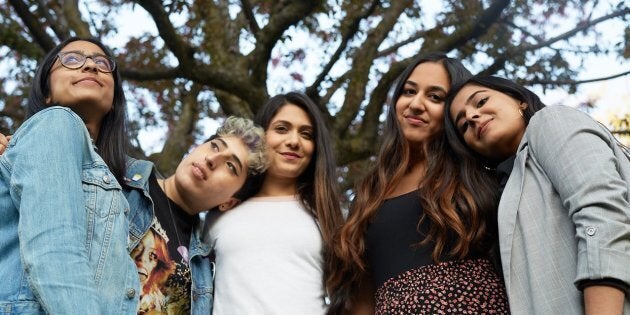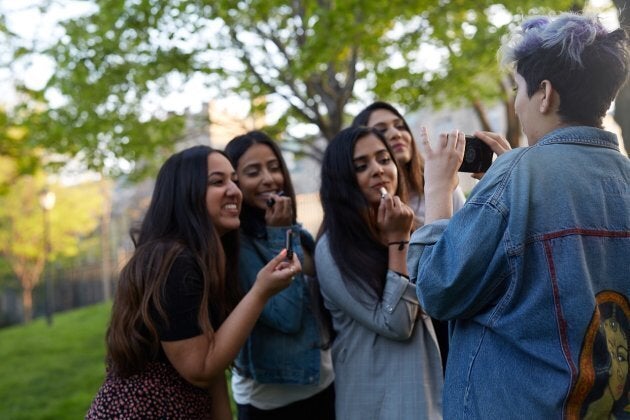

There's this antiquated notion that women can't have each other's backs. If there's one thing I've learned in my 20s in Toronto, it's that a woman will quite literally zip up the back of my dress as I struggle to leave the washroom lineup at a bar around 2 a.m.
Having a girl gang has been the bedrock of women's lives for as long as there have been women. We live in a time where fleeting friendships are more common than ever; where hearts and cute emojis have become our highest cultural currency. We're demanding more avenues to meet and network everywhere we go — even swiping for friends on apps like Bumble BFF.
It wasn't until eight years ago that I found my tribe in journalism school, at Ryerson University. Between long nights in editing suites and even longer rides on public transit, we quickly became a group of friends. I call them my "word witches" (yes, we all love Harry Potter) and we are constantly exploring the intricacies of being brown. Having immigrant parents gives you a certain set of experiences that only other people in the same boat — pun intended — can understand.

Some of us watch Indian films with subtitles because we don't speak Hindi at home. A few of us drink in front of our parents, while the others would be sent to their graves for smelling wine. Some of us live with our boyfriends in secret. Does this make us bad brown girls?
Some of our moms are Facebook friends with our boyfriends. Some of us live in intergenerational homes, where we have to prioritize time with nieces, nephews and grandmas before we can hang out with each other. Does this make us better brown girls?
Sometimes, we lie about where we're staying the night or who we're flying with across the Atlantic Ocean. Some of us have to help pay our parents' bills. And some of us have no extended family here at all.
There is something powerful about seeing a part of your experience reflected back to you, particularly in the small moments of your day. These quiet realities amongst us speak to the ways in which people of colour engage with the world. Discussions about culture and religion aren't reserved for podcasts — they're already embedded in our everyday experiences.

Being South Asian means we can spend countless hours talking about our smelly lunches in elementary school, or how we weren't allowed to go to sleepover parties, or how we need to hide our tattoos from anyone who is remotely related to us. It means we understand why some of us have a separate Instagram account for our relatives, or why we choose to lie to our parents about seeing a therapist. It means we feel the weight of our mothers' words during a job interview: "You will have to work three times harder to earn half the respect." It means we know the feeling of cleaning the entire house and pre-planning how to ask our parents if we can leave the house.
Among the largely unacknowledged truths of female life is that women's foundational friendships are just as important as the relationships society says we're supposed to form with our partners. So it's not surprising that headlines like "22 Ways Your Best Friend Is Actually Your Significant Other" resonate with us so much. The women in our lives are unapologetic in their affection for one another. We embrace making poor decisions together. We are the wing woman. The career counsellor. The personal stylist. We are each other's life coaches.
Finally, the duality of my identity isn't hiding in a footnote.
Toronto-based photographer Natalia Dolan took photos of my girl gang last spring for The Girl Friends Project— her ongoing photo exhibit that celebrates female friendships. "For me, female friendships are more intimate than others, and there's a bit of magic to them that I am exploring in this series," she told Flare. The project, which is colourfully displayed on Instagram, is careful not to compress women's narratives into a single story. If anything, Dolan is carving out little spaces of joy on social media — something that is hard to come by these days.
Now, the beauty and complexity of my real-life sisterhood is being reimagined online. First- and second-generation artists with hundreds of thousands of followers have helped legitimize the brown girl experience while growing up anywhere from New Zealand to North America.
Diasporic art on Instagram has blown up in recent years, and has become a new engine and defining trait of contemporary feminism. It has served as an entry point for deeper feminist engagement by harnessing the collective power of women of colour who are occupying traditionally unoccupied space online.
Artists like Simmi Patel, Badal Patel, Sketchy Desi, Maria Qamar and Frizz Kid (who happens to be part of my girl gang), are creating work that is inspired by the experiences of women of colour — vocalizing the stigma attached to brown skin and browner names. Now more than ever, it is becoming imperative for women to find safe and inclusive spaces online. South Asian diaspora art that captures our struggles with body hair and screenshots of bindi-adorned brown girls lamenting social injustices are all over Instagram. Scrolling through my social feeds and seeing these artists’ satirical takes on millennial life are a daily reminder that women who look like me and my friends are being heard.
When I see an enamel pin that says "chai or die" or a T-shirt silkscreened with "samosas and mimosas," I can't help but feel seen. I was raised by an Indian mom who grew up in northern Alberta and an Indian dad who went to a boarding school in a Himalayan resort town. Finally, the duality of my identity isn't hiding in a footnote on what it means to be a second-generation Canadian.
I love that my girl gang is as diverse as the brown girl experience. See us, hear us and stand behind us — in all the beautiful shades of our brown skin.
More from HuffPost Canada:
Born And Raised is an ongoing series by HuffPost Canada that shares the experiences of second-generation Canadians. Part reflection, part storytelling, this series on the children of immigrants explores what it means to be born and raised in Canada. We want to hear your stories — join the conversation on Twitter at #BornandRaised or send us an email at bornandraised@huffpost.com.
Also on HuffPost: